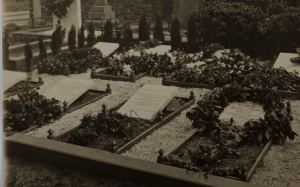Death in Detention: Internees whose lives ended on the Isle of Man – a perspective
Hamish Killip
The speaker’s interest, in what at first sight appears to be a rather macabre subject, was kindled by differences in the way that society marks and commemorates those who died in war. What happened after they died depended on aspects of their status, e.g. military or civilian, resident or internee and on some more subtle issues. Intrigued by apparent disparities, the speaker investigated a number of examples and gradually gained some understanding of what occurred and he will attempt to illustrate the subject with some specific cases. This activity of investigation has consisted of a series of puzzles each requiring a solution, often taxing the investigator’s abilities. Despite being frustrating, there were rewarding discoveries every so often, enough at least to justify carrying on with the study. This process has revealed various sidelights on the lives and deaths of internees and the involvement of the Island and its people. The speaker will attempt to summarise his findings.
This investigation is inevitably partial and, unlike that of academics, neither exhaustive nor as intellectually rigorous. A key message may be that if someone like the speaker can pursue this rather obscure topic, then so can most of those occupying the seats in the Elmwood House lecture theatre.

